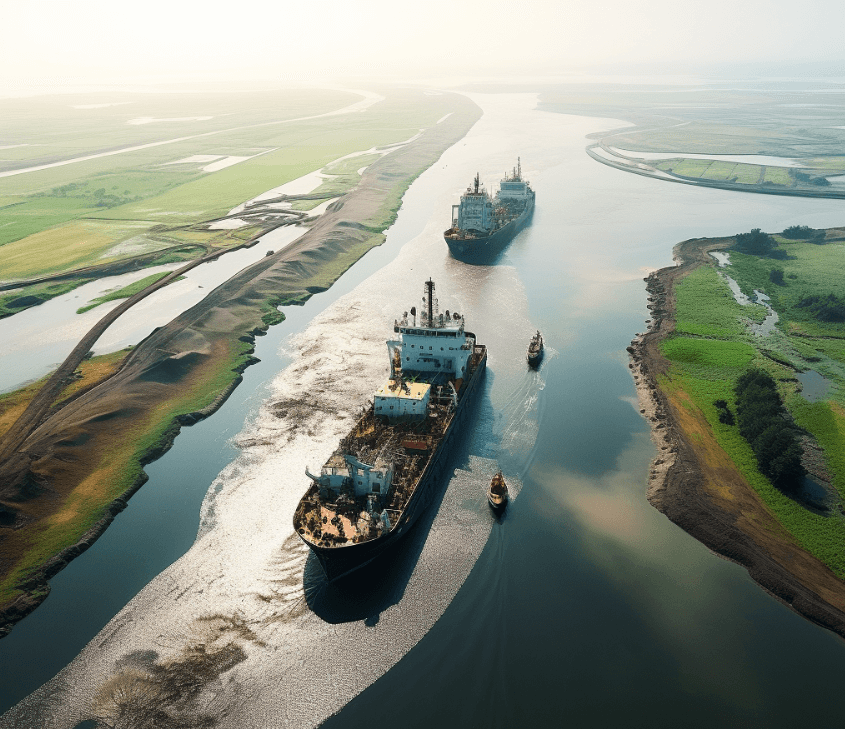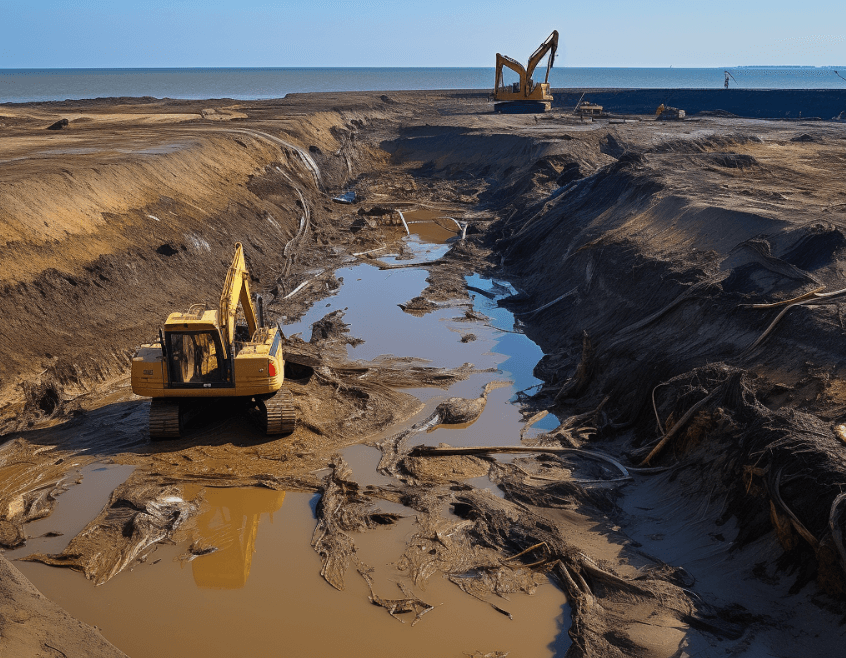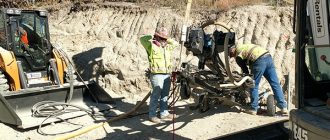What are Dredge Spoils?
Dredging is a common practice in maintaining and improving waterways for navigation and flood control. It involves the excavation of materials, known as dredge spoils, from the bottom of rivers, lakes, and harbors. While this process is essential for keeping waterways accessible, the management and disposal of the dredged sediment pose significant challenges.
The impacts of dredging spoil are multifaceted. On one hand, the removal of sediment can improve navigation by clearing channels and deepening waterways. This allows for the safe passage of larger ships and enhances the efficiency of trade and transportation. On the other hand, dredged material can be contaminated with pollutants such as heavy metals and toxic chemicals, posing a threat to aquatic ecosystems and human health.
The management of dredge spoils is crucial in minimizing these impacts. One approach is to treat and dispose of the sediment in designated areas on land, such as dredge material placement sites or landfills. This requires careful consideration of the composition and toxicity of the sediment, as well as compliance with environmental regulations. Another option is the beneficial use of dredge spoils, where the sediment is used for purposes like wetland restoration or beach replenishment. This can provide ecological benefits while reducing the need for off-site disposal.
The understanding of dredge spoils and their impact on waterways continues to evolve. Scientists and engineers are exploring innovative solutions for dredging sediments, such as the use of bioremediation techniques to treat contaminated material or the development of sustainable dredging practices. By better managing and minimizing the environmental consequences of dredging, we can ensure the long-term health and sustainability of our waterways while maintaining vital navigation routes.
Understanding Dredge Spoils
Dredging plays a crucial role in the maintenance and development of channels, waterways, and navigation systems. During the process of excavation and clearing sediment, known as dredging, a substantial amount of materials, known as dredge spoils, is produced.
Dredge spoils refer to the materials that are removed from the waterways, including sediments, rocks, debris, and other materials. These spoils are typically transported and deposited in designated areas for proper disposal.
Understanding dredge spoils is important as it entails both environmental and economic considerations. The management and disposal of these spoils must be carefully planned to minimize negative impacts and ensure the sustainability of waterway systems.

Channels, waterways, and navigation systems require regular maintenance to ensure safe and efficient navigation for vessels of all sizes. Dredging helps to remove accumulated sediments, which can hinder navigation and pose a safety risk. By excavating and removing these sediments, waterways can be maintained at their intended depths, allowing for smooth and unobstructed passage of vessels.
When considering the impact of dredge spoils, the following factors should be taken into account:
- Environmental impact: The disposal of dredge spoils can potentially affect aquatic ecosystems. Care must be taken to minimize the release of harmful substances, such as heavy metals or contaminants, into the water during the disposal process.
- Sediment composition: Understanding the composition of dredge spoils is essential to determine the most appropriate disposal method. Some spoils may be suitable for beneficial uses, such as beach nourishment or land reclamation, while others may require specialized treatment or containment.
- Management and regulations: Proper management and regulations are necessary to ensure the responsible handling and disposal of dredge spoils. Compliance with environmental standards and regulations is crucial to protect water quality and minimize negative impacts.
Efforts are being made to find innovative and sustainable solutions for the management of dredge spoils. This includes exploring options for beneficial reuse, such as using dredge spoils for wetland restoration or creating artificial habitats.
AdvantagesDisadvantages
|
|
In conclusion, understanding dredge spoils is crucial for the effective and sustainable management of waterways and navigation systems. By considering the environmental impact, sediment composition, and implementing proper regulations and management practices, the negative effects of dredge spoils can be minimized, while also exploring opportunities for beneficial reuse.
Exploring the Impact
In the process of dredging, which involves the excavation of sediment from channels and waterways to maintain navigation, the impact on the environment and surrounding areas is significant. The management and disposal of dredge materials need to be carefully considered to minimize negative consequences.
One of the main impacts of dredging is the disturbance of sediment. Dredging stirs up the sediment, which can release contaminants and nutrients into the water column. This can have adverse effects on water quality, as well as the health of aquatic organisms. Sediment disturbance can also lead to increased turbidity, reducing light penetration and affecting photosynthesis.
The disposal of dredge spoils is another important aspect to consider. Dredged sediment is often disposed of in designated areas called disposal sites. However, the selection and management of these sites is crucial to prevent further harm to the environment. Improper disposal can result in sediment runoff, impacting nearby ecosystems and potentially causing sedimentation of natural waterways.
Some of the key impacts of dredging and sediment disposal include:
- Erosion of coastal areas
- Loss of critical habitats
- Alteration of water flow patterns
- Disruption of sediment transport
- Changes in water chemistry
Understanding and mitigating these impacts is essential for the sustainable management of dredging operations. By implementing proper sediment management practices, such as using sediment traps and recycling dredge materials, the overall impact on the environment can be reduced.
The impacts of dredging and sediment disposalPotential consequences
| Erosion of coastal areas | Loss of land, increased vulnerability to storms |
| Loss of critical habitats | Disruption of ecosystems, loss of biodiversity |
| Alteration of water flow patterns | Changes in sediment transport, erosion or sedimentation in other areas |
| Disruption of sediment transport | Redistribution of sediment, impacts on aquatic organisms |
| Changes in water chemistry | Altered nutrient levels, decreased water quality |
In conclusion, the impact of dredging and sediment disposal on the environment is significant and should be carefully managed. By understanding the potential consequences and implementing proper sediment management practices, the negative effects can be minimized, ensuring the long-term sustainability of waterways and ecosystems.
Management of Sediments
Managing sediments is an essential aspect of maintaining waterways and navigation channels. Dredging, the process of removing materials from the bottom of water bodies, is often necessary to ensure the safe passage of vessels. The sediments removed during dredging, known as dredge spoils, can pose challenges in terms of disposal and environmental impact.
Dredging:

Dredging is typically performed to maintain or improve navigation channels, allowing for ships and boats to travel safely. Sediment accumulation over time can cause channels to become shallow, making navigation difficult or even dangerous. By removing sediments, dredging helps maintain the desired depth of waterways.
Sediment Characterization:
Prior to dredging, it is important to characterize the sediments to determine their composition and potential contaminants. Sediment testing can assess the suitability of disposal options and potential impacts on water quality and marine life.
Disposal Options:
There are various options for disposing of dredged sediments. These options depend on the composition of the sediments and local regulations. Some commonly used disposal methods include:
- Placement in designated upland sites
- Creation of containment structures or dikes
- Beneficial reuse in construction projects
- Offshore placement in designated areas
Environmental Considerations:
When managing sediments, it is crucial to consider the potential environmental impacts. Sediments can contain pollutants and contaminants, such as heavy metals or organic compounds. Proper disposal methods and monitoring can help minimize these impacts and protect water quality and aquatic ecosystems.
Monitoring and Adaptive Management:
Monitoring the effectiveness of sediment management strategies is important to evaluate their impact and adjust practices if necessary. Regular monitoring of water quality, sediment composition, and biological indicators can provide valuable information to guide decision-making and improve future sediment management efforts.
In conclusion, the management of sediments plays a crucial role in maintaining navigation channels and waterways. Proper characterization, disposal, and monitoring techniques help ensure the safety and sustainability of our water resources.
Environmental Consequences
Navigation and maintenance dredging activities can have significant environmental consequences, particularly in regards to the sediment and waterways. When navigation channels and waterways become obstructed by sediment, it becomes necessary to excavate and remove these materials to maintain safe navigation for vessels.
The disposal of dredge spoils can have several potential environmental impacts. The sediment dredged from the waterways may contain contaminants, such as heavy metals or organic pollutants, which can be harmful to aquatic ecosystems. As a result, it is crucial to properly handle and dispose of these materials to minimize their impact on the environment.
One common method of disposal is to place the dredged sediment in designated areas, known as disposal sites. These sites are carefully selected and managed to prevent the spread of contaminants and minimize the disturbance to surrounding ecosystems. However, if not properly managed, the disposal of dredge spoils can lead to sedimentation, smothering of benthic habitats, and changes in water quality.
Another environmental consequence of dredging activities is the alteration of natural sediment transport processes. Dredging can disrupt the natural balance of sediment deposition and erosion, leading to increased erosion rates in some areas and decreased sediment availability in others. This can have detrimental effects on the stability of coastal and riverine ecosystems, including the loss of habitat for aquatic plants and animals.
Furthermore, dredging activities can generate underwater noise and vibrations, which can disturb marine mammals, fish, and other aquatic species. These disturbances can impact their behavior, communication, and breeding patterns. To mitigate these impacts, measures such as using quieter dredging equipment and implementing noise reduction strategies can be employed.
In summary, while dredging plays an essential role in maintaining navigation channels and waterways, it is important to carefully consider and manage the environmental consequences associated with these activities. Proper handling and disposal of dredge spoils, as well as the implementation of mitigation measures, are crucial to minimize the impact on aquatic ecosystems and maintain the overall health of our waterways.
Ecosystem Effects
Dredging is often necessary to maintain the navigability of waterways and channels. However, the disposal of dredged sediment can have significant effects on ecosystems in and around these water bodies.
When sediment is excavated from the bottom of waterways, it can contain a variety of materials, including organic matter, nutrients, and potentially contaminants. These materials can have both positive and negative impacts on the surrounding ecosystem.
The deposition of dredged sediment can provide a source of organic matter and nutrients to the receiving ecosystem. This can stimulate primary productivity and support the growth of vegetation and aquatic organisms. In some cases, it can even create new habitats for various species.
However, the introduction of sediment can also have detrimental effects. The increased sediment load can reduce water clarity and light penetration, inhibiting photosynthesis and impacting the health of submerged aquatic vegetation. The sediment can also smother benthic organisms and disrupt their habitats.
Furthermore, the dredged sediment may contain contaminants such as heavy metals or pollutants, which can be released into the water column and have toxic effects on aquatic organisms. These contaminants can accumulate in the food chain, potentially affecting higher trophic levels.
To mitigate the potential negative impacts of dredge disposal, various management strategies can be employed. These include sediment testing and characterization, sediment treatment and containment, and the implementation of environmental monitoring programs.
Common Ecosystem Effects of Dredge DisposalPositive EffectsNegative Effects
|
|
By carefully considering the potential ecosystem effects of dredge disposal and implementing appropriate management practices, it is possible to minimize negative impacts and maintain the balance of these fragile ecosystems.
Sediment Accumulation
Sediment accumulation is the process by which waterways and bodies of water accumulate sediment and other materials over time. Sediment can be naturally occurring, or it can be the result of human activities such as excavation or dredging.
When sediment accumulates in waterways, it can pose a range of challenges for navigation and the health of aquatic ecosystems. Excessive sedimentation can narrow or block navigation channels, affecting the ability of boats and ships to safely navigate through the water. This can have a significant impact on commercial and recreational activities that rely on open and accessible waterways.
In addition to impacting navigation, sediment accumulation can also affect the health of aquatic ecosystems. Sediment can smother and suffocate fish and other aquatic organisms, limit the availability of light for photosynthesis, and disrupt aquatic habitats such as spawning grounds and feeding areas.
To manage sediment accumulation, various strategies and technologies can be employed. One common method is dredging, which involves the removal of sediment from waterways using specialized equipment. Dredging can help to restore navigation channels and improve water access. However, the disposal of dredged sediment can be a challenge, as it must be carefully managed to avoid negative impacts on the environment.
Another approach to managing sediment accumulation is the implementation of erosion control measures. These measures aim to prevent or mitigate the erosion of sediment from land surfaces into waterways. They can include the use of vegetative buffers, soil stabilization techniques, and sediment retention ponds.
Furthermore, sediment accumulation can also be managed through the implementation of best management practices in land use planning and construction activities. By considering the potential impacts of sedimentation during the planning and design stages, it is possible to reduce the amount of sediment that enters waterways and accumulates over time.
Overall, sediment accumulation is a complex issue that requires a multidisciplinary approach. By understanding the causes and impacts of sediment accumulation, and implementing effective management strategies, it is possible to ensure the long-term health and sustainability of waterways and aquatic ecosystems.
Water Quality Implications
When it comes to dredging activities in channels and waterways, the excavation of materials can have significant implications for water quality. The process of dredging involves the removal of sediments or spoils from the bottom of water bodies to maintain or improve navigation.
One of the main concerns regarding dredging activities is the disposal of dredge spoils. These spoils often contain various contaminants such as heavy metals, organic pollutants, and nutrients. When these spoils are disposed of improperly, they can have negative impacts on water quality.
The disposal of dredge spoils into water bodies can lead to increased sedimentation, which can reduce water clarity and limit light penetration. This can negatively impact the growth of aquatic vegetation, which in turn affects the health of the overall ecosystem.
Furthermore, the release of contaminants from the dredge spoils can pose risks to aquatic life and human health. Heavy metals and organic pollutants can accumulate in the tissues of aquatic organisms, leading to long-term negative effects on their reproductive, immune, and neurological systems.
To mitigate the water quality implications of dredging activities, proper disposal and management of dredge spoils are essential. Contaminated spoils should be handled and disposed of in accordance with regulatory standards to minimize adverse effects on water quality.
In some cases, beneficial uses can be found for dredge spoils. For example, spoil materials with low contaminant levels can be used for habitat restoration or land reclamation projects. This approach not only reduces the environmental impact of disposal but also provides potential benefits to the surrounding ecosystem.
In summary, dredging activities have important water quality implications that need to be carefully managed. Proper disposal of dredge spoils and adherence to regulatory standards are crucial to minimize the negative impacts on aquatic ecosystems and human health.
Human Health Risks
The management of dredge spoils is crucial for protecting human health, as these materials can potentially pose risks to individuals and communities living near waterways.
Dredging involves the removal of sediment from channels and navigation areas to maintain or improve navigation. The excavated sediment, or dredge spoils, typically contain a mixture of organic and inorganic materials.
The disposal of dredge spoils can result in the release of contaminants that may have accumulated in the sediment over time. These contaminants include heavy metals, polycyclic aromatic hydrocarbons (PAHs), polychlorinated biphenyls (PCBs), and pesticides.
Exposure to these contaminants can occur through direct contact with the sediment or through the ingestion of contaminated water or food. Fish and other aquatic organisms can accumulate these contaminants in their tissues, posing a potential risk to human health if consumed.
Contaminated sediment can also impact human health indirectly by affecting the ecosystem and food chain. For example, sediment containing high levels of contaminants can harm fish and other aquatic life, leading to declines in fish populations and affecting the livelihoods of communities that depend on fishing.
Furthermore, dredging activities can disturb the sediment, potentially releasing contaminants into the water column and increasing water turbidity. This can negatively impact water quality and the ability of aquatic organisms to thrive.

To protect human health, proper management and disposal of dredge spoils are essential. This includes screening the sediment for contaminants before disposal and adopting alternative disposal methods, such as capping or containment, for contaminated sediments.
Regulatory agencies and environmental organizations play a crucial role in the monitoring and enforcement of sediment management practices to mitigate human health risks. Ongoing research and monitoring are necessary to better understand the long-term impacts of dredge spoils on human health and to develop effective management strategies.
In conclusion, the management of dredge spoils is vital for safeguarding human health and the environment. By implementing proper sediment management practices and monitoring protocols, we can minimize the potential risks associated with dredged materials and ensure the protection of waterways and the communities that rely on them.
Disposal Techniques
When conducting dredging operations in navigable waterways, the process often results in the accumulation of dredge spoils, which are sediment materials that have been excavated from the channels. The management and disposal of these spoils is a critical aspect of dredging projects, as improper disposal techniques can have negative ecological and economic impacts on the surrounding environment.
There are several disposal techniques that can be employed to handle the dredge spoils effectively:
- Containment and Capping: This technique involves confining the dredge spoils within designated containment areas and placing a protective cap over the top to prevent the dispersion of sediment into the water column. It is commonly used when the spoils are contaminated with pollutants.
- Upstream Placement: In this technique, the dredge spoils are transported and placed in an upstream location, allowing natural processes, such as sediment transport and deposition, to disperse and redistribute the material over time.
- Beach Nourishment: This technique involves placing the dredged sediment along eroded coastlines to restore and enhance beach areas. It can help protect against coastal erosion and promote the formation of dunes and natural habitats.
- Containment Islands: This technique involves using the dredged sediment to create islands or marshes within the waterways. These islands can serve as habitats for wildlife, enhance water quality, and provide erosion control.
Furthermore, the choice of disposal technique depends on various factors, including the type of sediment, the presence of contaminants, environmental regulations, and the intended use of the disposal area.
Dredge spoils management and disposal are essential components of dredging projects, ensuring the sustainable and proper maintenance of navigation channels and waterways while minimizing the ecological impact on the surrounding environment.
Regulatory Framework
The management and disposal of dredge spoils is subject to a regulatory framework established by various government agencies. These regulations aim to ensure that sediment removal and disposal activities are carried out in an environmentally responsible manner, while also considering the needs of navigation and other water-dependent uses.
The primary regulatory agencies involved in the management of dredge spoils include the U.S. Army Corps of Engineers (USACE), the Environmental Protection Agency (EPA), and state and local authorities. These agencies work together to develop and enforce regulations governing the dredging and disposal of sediments in navigable channels and waterways.
One of the key elements of the regulatory framework is the permitting process. Prior to any dredging or excavation activities, project proponents must obtain permits from the appropriate regulatory agencies. These permits outline the conditions and requirements for sediment removal and disposal, and often require the submission of comprehensive environmental impact assessments.
The regulatory framework also includes specific guidelines for the management of dredge spoils. These guidelines address issues such as testing and characterization of sediment materials, methods for sediment disposal, and monitoring requirements. They aim to ensure that dredge spoils are properly managed to minimize potential impacts on water quality, habitats, and other ecological resources.
In addition to the regulatory agencies, other stakeholders, including environmental organizations and local communities, often play a role in the decision-making process. Public input and involvement are important in balancing the needs of navigation and other water-dependent uses with the protection of natural resources.
The enforcement of regulations is another critical aspect of the regulatory framework. Violations of the regulations can result in penalties and fines, as well as requirements for remediation or mitigation measures. Regular inspections and monitoring are conducted to ensure compliance with the regulatory requirements.
Key points of the regulatory framework:
|
In conclusion, the regulatory framework for the management of dredge spoils seeks to ensure the responsible and sustainable removal and disposal of sediment materials from navigational channels. Through the permitting process, comprehensive guidelines, and enforcement measures, the impacts on water quality, habitats, and other ecological resources are minimized. Public input and involvement further contribute to the decision-making process, balancing the needs of navigation with environmental protection.
Best Management Practices
The management of dredge spoils is a crucial aspect in ensuring the sustainable and effective management of our waterways and navigation channels. Proper disposal and management of these materials help to maintain the safety, functionality, and environmental integrity of our waterways. Here are some best management practices to consider:
- Evaluate the quality of spoils: Before disposing of dredge spoils, it is important to assess the quality and composition of the sediment. Sediments with high levels of contamination may require special treatment or disposal methods to minimize their impact on the environment.
- Reduce, reuse, and recycle: Whenever possible, consider options to reduce, reuse, or recycle dredge spoils. This can involve using the sediment for beneficial purposes such as beach nourishment, wetland restoration, or construction projects.
- Implement sediment management plans: Develop and implement sediment management plans that outline the goals, objectives, and strategies for dealing with dredge spoils. These plans should consider the long-term management of the sediment, including monitoring and adaptive management approaches.
- Use proper disposal methods: When disposal is necessary, select appropriate sites and methods that minimize the potential impact on water quality and ecosystems. This may involve utilizing designated disposal areas and following strict guidelines for containment and monitoring.
- Consider beneficial use projects: Explore opportunities for beneficial use projects, which involve utilizing dredge spoils as a resource rather than treating them as waste. These projects can provide economic and environmental benefits, such as habitat creation, shoreline stabilization, or nutrient recycling.
Note: It is essential to comply with local, state, and federal regulations when implementing any management practices for dredge spoils. These regulations may vary depending on the location and characteristics of the sediment.
By implementing these best management practices, we can ensure the responsible and sustainable management of dredge spoils, while protecting the health and integrity of our waterways and ecosystems.
Cost Considerations
When it comes to managing dredge spoils and sediment in waterways, cost considerations play a significant role in the decision-making process. Excavating and disposing of these materials can be an expensive endeavor, and several factors contribute to the overall cost. Understanding these cost considerations helps policymakers and stakeholders make informed decisions about sediment management strategies.
Volume of Sediment
One of the primary factors affecting dredge spoil management costs is the volume of sediment that needs to be excavated and removed. Larger volumes of sediment require more extensive excavation and disposal operations, resulting in higher costs. Accurate assessments of the sediment volume are crucial for determining the scope of the project and estimating the associated expenses.
Dredging Methods
The choice of dredging method also influences the cost of managing sediment. Different methods, such as hydraulic dredging, mechanical dredging, or clamshell dredging, have varying efficiencies and associated costs. Factors like the type of sediment, depth of the waterway, and accessibility also impact the selection of the dredging method.
Disposal Options
The disposal of dredge spoils is another cost consideration. Depending on the regulations and available options, sediment can be disposed of in various ways. Some common disposal methods include open-water placement, confinement in containment areas or landfills, and beneficial reuse for purposes such as beach nourishment or habitat restoration. Each disposal option has different associated costs, which need to be factored into the overall sediment management plan.
Transportation
Transporting the dredged sediment from the excavation site to the disposal location is often a significant expense. The distance between these two points, the mode of transportation (such as barges or trucks), and the availability of suitable transportation infrastructure all impact the cost of sediment disposal. Efficient transportation planning and logistics can help minimize costs in this aspect.
Regulatory Compliance
Compliance with environmental regulations and permits is necessary during sediment management projects. Obtaining permits and meeting regulatory requirements can be time-consuming and costly. Failure to comply with these regulations can result in fines and penalties, adding to the overall expenses of the project.
Maintenance and Monitoring
Lastly, ongoing maintenance and monitoring costs should be considered. Sedimentation in waterways is an ongoing process, and periodic dredging may be required to keep channels navigable. Regular monitoring to assess sediment accumulation and plan for future maintenance activities also contributes to the cost of sediment management.
Summary of Cost ConsiderationsCost ConsiderationDescription
| Volume of Sediment | The amount of sediment that needs to be excavated and removed. |
| Dredging Methods | The technique used for the excavation of sediment. |
| Disposal Options | The available methods for disposing of dredge spoils. |
| Transportation | The cost of transporting sediment from the excavation site to the disposal location. |
| Regulatory Compliance | The expenses associated with obtaining permits and complying with environmental regulations. |
| Maintenance and Monitoring | The ongoing costs of maintaining navigable waterways and monitoring sediment accumulation. |
Considering these cost factors helps stakeholders develop cost-effective sediment management strategies that balance the need for maintaining waterway functionality with the available resources and environmental considerations.
Future Research Directions
The topic of understanding dredge spoils and managing sediment disposal is an ongoing area of research. As technology continues to advance and the demand for navigation channels increases, there are several key areas that warrant further investigation. Future research directions in this field include:
- Dredge material characterization: In order to better understand the composition and properties of dredged materials, future research efforts should focus on developing more accurate and efficient methods for characterizing sediment. This could include the use of advanced imaging techniques or the development of new analytical tools to assess the chemical and physical properties of dredge spoils.
- Environmental impacts: Further research is needed to assess the long-term environmental impacts of dredging activities and sediment disposal. This could involve studying the effects of dredging on aquatic habitats, water quality, and the overall ecosystem. Understanding these impacts will inform better management practices and help mitigate any negative effects on the environment.
- Sustainable disposal options: Current methods of sediment disposal, such as ocean disposal or landfilling, may not be sustainable in the long term. Future research should explore alternative disposal options, such as beneficial reuse of dredge spoils for land reclamation or construction materials. Developing innovative and sustainable disposal practices will help minimize the environmental impact of sediment disposal.
- Smart dredging techniques: Advances in technology have the potential to revolutionize the dredging process. Future research efforts should focus on developing “smart” dredging techniques that use real-time data and feedback to optimize dredge operations. This could involve the use of sensors, remote sensing technologies, and machine learning algorithms to improve the efficiency and effectiveness of dredging activities.
- Integrated management strategies: To ensure the long-term sustainability of navigation channels and the surrounding environment, it is crucial to develop integrated management strategies for dredge spoils. Future research should focus on developing models and tools that can help decision-makers assess the trade-offs between navigation requirements, environmental impacts, and cost considerations. This will enable more informed and balanced decision-making in sediment management.
By addressing these future research directions, we can gain a deeper understanding of dredge spoils and develop more sustainable and effective management practices for sediment disposal. This will help protect our waterways, preserve aquatic habitats, and ensure the continued viability of navigation channels.
FAQ:
What are dredge spoils?
Dredge spoils are the sediments and other materials that are removed from the bottom of water bodies during dredging operations to deepen navigation channels or create new land.
How do dredge spoils impact the environment?
Dredge spoils can have a negative impact on the environment. When they are disposed of inappropriately, they can contaminate water bodies, harm marine life, and disrupt ecosystems. However, if managed properly, dredge spoils can also have positive impacts, such as creating new habitats and replenishing eroded shorelines.
What are the methods for managing dredge spoils?
There are several methods for managing dredge spoils. One common method is dewatering, where the sediments are allowed to dry and solidify before being disposed of or used for beneficial purposes. Another method is land disposal, where the spoils are deposited on land away from water bodies. Other options include beneficial use, where the spoils are used for purposes like beach replenishment or wetland restoration, and containment, where the spoils are confined in controlled areas.
Are there any regulations in place for managing dredge spoils?
Yes, there are regulations in place to manage dredge spoils. These regulations vary by country and region, but generally aim to ensure that dredge spoils are disposed of or used in ways that minimize negative impacts on the environment. Some common requirements include testing the spoils for contaminants, obtaining permits for disposal or beneficial use, and following specific guidelines for management and monitoring.






